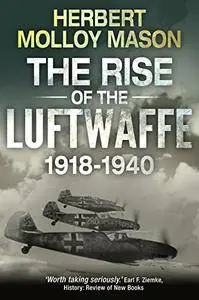The Rise of the Luftwaffe, 1918-1940 by Herbert Molloy Mason
English | 8 Nov. 2016 | ISBN: 1539898709 | 277 Pages | MOBI/EPUB/PDF | 3.88 MB
English | 8 Nov. 2016 | ISBN: 1539898709 | 277 Pages | MOBI/EPUB/PDF | 3.88 MB
“The campaign in Poland proved the Luftwaffe to be the Wehrmacht’s loudest trumpet. The rest of the world… was stunned at the overrunning of sixty thousand miles of courageously defended terrain in only twenty-six days.”
In the winter of 1918, Germany’s conquerors set about rendering the Reich forever incapable of waging war.
The existing German Air Service of nearly 15,000 planes was to be scrapped - the treaty of Versailles would ensure that no military aircraft would ever be flown in Germany again.
But less than a generation later Europe shook before the threat of the Luftwaffe, believed to be the most powerful air force in the world.
The Rise of the Luftwaffe tells how it happened.
Denied warplane factories and flying schools in their homeland, the Germans built them in Russia and it was there that they trained an elite pilot corps.
At home state-sponsored gliding schemes gave a new generation of pilots their first taste of the air, and clandestine factories, ostensibly making perambulators or washing machines, turned out warplanes.
As confidence grew, and the actual restrictions on German aviation eased, so a new dimension was added to the bluff.
Germany’s re-occupation of the Rhineland was carried out under cover of planes lacking guns and ammunition; the Luftwaffe’s apparent capability was exaggerated by the use of stripped-down versions of fighters in speed-record attempts.
Now, instead of concealing the existence of their air power from the rest of Europe, the Germans were concealing its limitations.
Herbert Molloy Mason charts every step of the subterfuge and ingenuity by which the transformation was brought about.
He describes the pioneering of new developments such as the Stuka dive-bomber, and the proving of this secretly trained and created air force first in the Spanish Civil War and later against Poland and France.
At the same time he explodes some of the myths of German technical and organizational superiority: meddling by Hitler, bickering between designers and bureaucrats, and ineptitude by the morphine-addicted Goering cost the Luftwaffe a war-winning strategic bomber force and jet fighters even before World War II began.
Praise for Herbert Molloy Mason
‘Worth taking seriously.’ - Earl F. Ziemke
Herbert Molloy Mason (1927-2013) was a noted writer of military history, and wrote sixteen books, including The Lafayette Escadrille and To Kill Hitler. He lived in San Antonio, Texas with his wife who was an artist.



